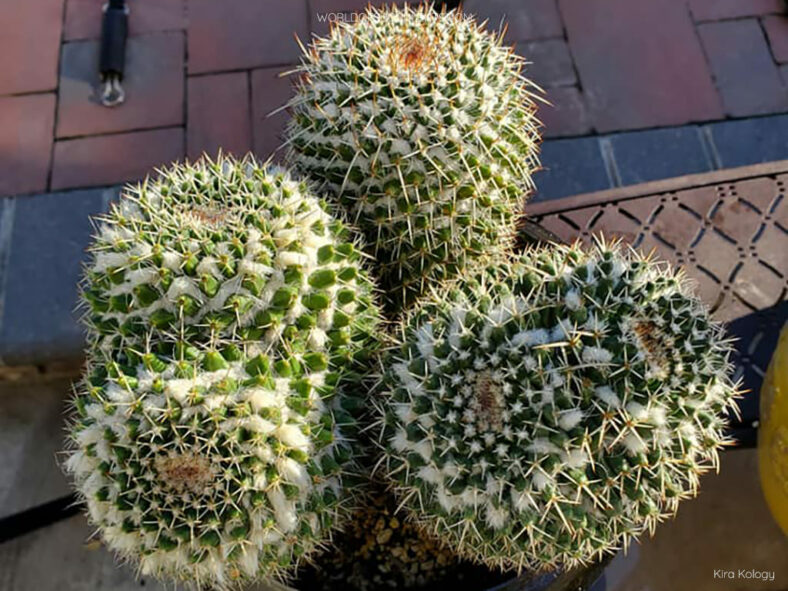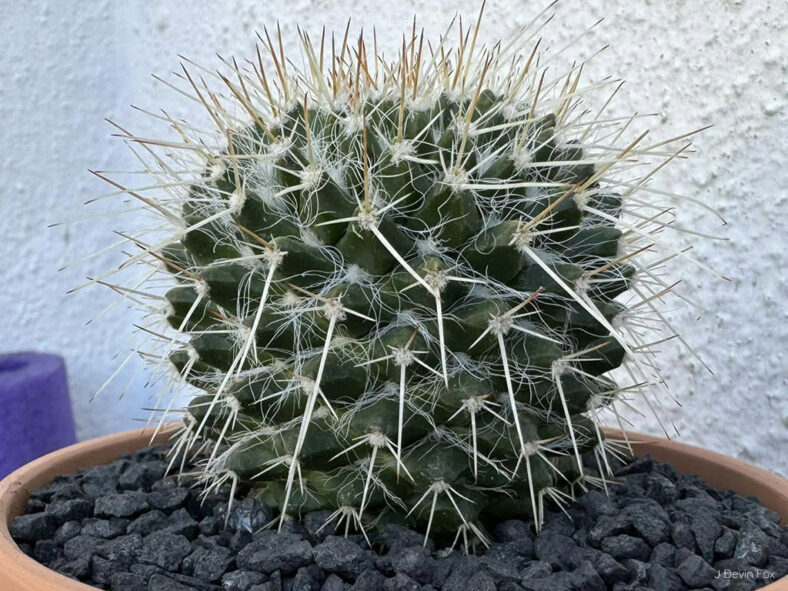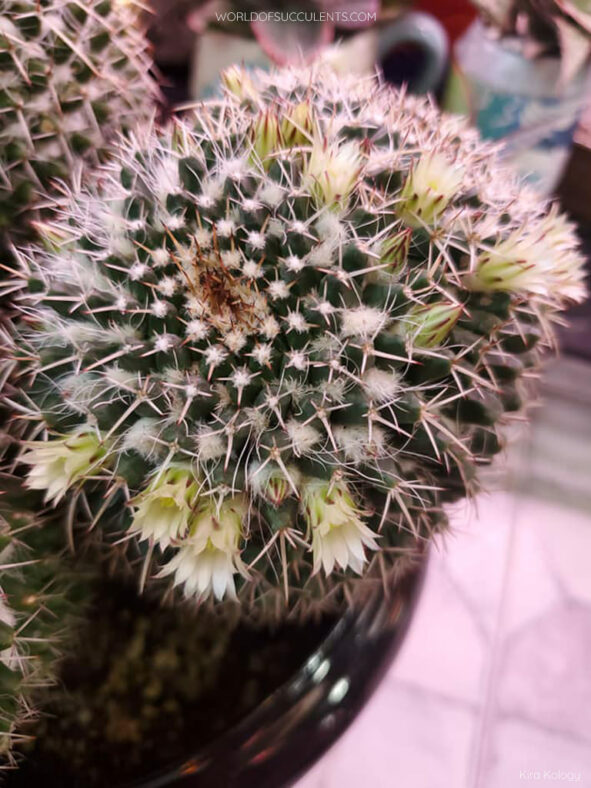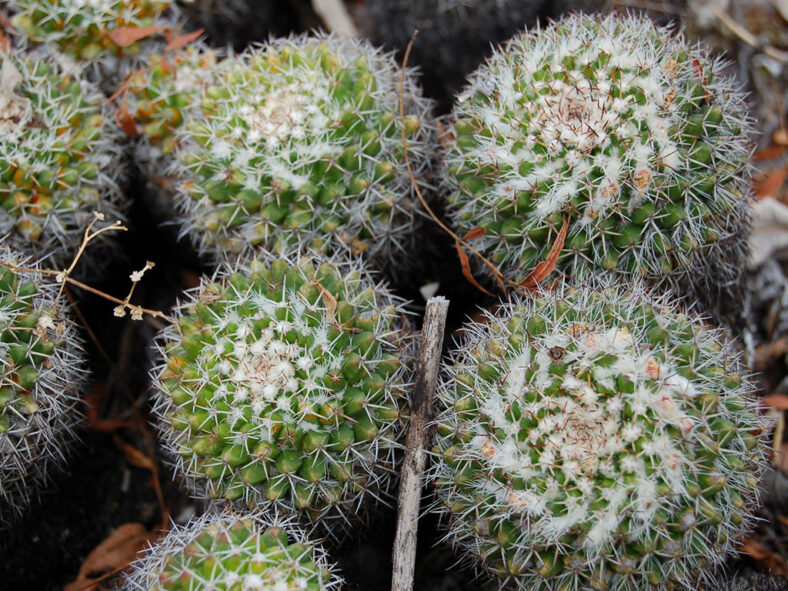Mammillaria karwinskiana subsp. nejapensis is a highly variable subspecies, particularly in terms of the length of its spines. Its flowers are white with midveins tinted red, and have 3 to 5 radial spines and no central spines. On the other hand, Mammillaria karwinskiana subsp. karwinskiana has cream to medium-yellow flowers with purplish midveins, usually six radial spines, and no central spines.
Scientific Name
Mammillaria karwinskiana subsp. nejapensis (R.T.Craig & E.Y.Dawson) D.R.Hunt
Common Name(s)
Owl Eyes, Owl Eyes Cactus, Royal Cross, Royal Cross Cactus, Silver Arrows
Synonym(s)
Mammillaria geminata subsp. nejapensis, Mammillaria nejapensis, Neomammillaria nejapensis
Scientific Classification
Family: Cactaceae
Subfamily: Cactoideae
Tribe: Cacteae
Subtribe: Cactinae
Genus: Mammillaria
Etymology
The specific epithet "nejapensis (pronounced ne-juh-PEN-sis)" refers to the occurrence of this subspecies near Nejapa de Madero, a town and municipality in Oaxaca in southwestern Mexico.
Origin
Mammillaria karwinskiana subsp. nejapensis is native to Mexico. It grows in tropical deciduous forests and xerophilous scrub at elevations between 3,790 and 5,410 feet (850 and 1,650 m) around Nejapa in the northwestern region.
Description
Mammillaria karwinskiana subsp. nejapensis, also known as Mammillaria nejapensis, is a small cactus with green to bluish-green stems with pyramidal, spirally arranged tubercles. The stems are spherical to slightly columnar and can grow up to 6 inches (15 cm) tall and 3 inches (7.5 cm) in diameter. They can be solitary, slowly basally branching, or dichotomously branching. The tubercles have clusters of spines and tufts of white hair at the tip, as well as long white bristles in the axils. Initially, the spines are cream to reddish with brown tips, but they become silvery white with age. They are straight to slightly curved and can reach more than 2 inches (5 cm) long. Each areole bears 3 to 5 radial spines, and the central spines are absent.
During the spring season, Mammillaria karwinskiana subsp. nejapensis produces white, funnel-shaped flowers with red-tinted midveins. The flowers form a circle around the stems, just below the apex, measuring up to 1 inch (2.5 cm) in length and 0.6 inches (1.5 cm) in diameter. The fruits are red, club-shaped, and quite attractive, containing tiny brown seeds.

How to Grow and Care for Mammillaria karwinskiana subsp. nejapensis
Light: For optimal growth of your Mammillaria karwinskiana subsp. nejapensis, ensure it is planted in an area that receives at least four hours of direct sunlight daily. If growing indoors, placing the cactus near a bright window is best. For additional light, it is advisable to keep it on the balcony or in the garden from spring to fall.
Soil: To ensure good root aeration and drainage, use commercial cactus soil or create your own well-draining soil mix.
Temperature: Mammillaria karwinskiana subsp. nejapensis is heat-tolerant but is not a cold-hardy plant. It grows best in USDA Plant Hardiness Zones 9b to 11b, with average minimum winter temperatures ranging from 25°F to 50°F (- 3.9°C to 10°C).
Watering: Water deeply from spring to fall, and wait until the soil dries out before watering again. Never let your pot sit in water, and suspend watering when the plant goes dormant in the winter.
Fertilizing: During the growing season, Mammillaria karwinskiana subsp. nejapensis benefits from fertilizing. Apply a water-soluble fertilizer for cacti and other succulents. Suspend feeding during the winter when the plant goes dormant.
Repotting: Repot the cactus into a slightly larger pot every two or three years, preferably during late winter or early spring. However, repotting can be done at any time of the year.
Propagation: There are two easy ways to propagate Mammillaria karwinskiana subsp. nejapensis: by seeds or by dividing offsets. The best time to remove offsets is in spring and summer. Sow the seeds in late spring or summer for the best results.
Learn more at How to Grow and Care for Mammillaria.
Toxicity of Mammillaria karwinskiana subsp. nejapensis
Mammillaria karwinskiana subsp. nejapensis is non-toxic but has sharp spines, so keep it away from children and pets.
Links
- Back to genus Mammillaria
- Succupedia: Browse succulents by Scientific Name, Common Name, Genus, Family, USDA Hardiness Zone, Origin, or cacti by Genus
Photo Gallery
Click on a photo to see a larger version.


